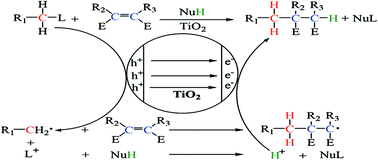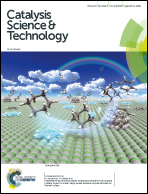TiO2 photocatalysis for C–C bond formation
Abstract
TiO2-based nanocrystal semiconductor materials are attracting attention as novel promising catalysts for the application of solar energy in organic synthesis. Due to the strong oxidative ability of the photo-induced hole in the TiO2 valence-band (h+vb) (2.9 V vs. NHE), under UVA or sunlight irradiation, TiO2 nanomaterials have enough ability to activate and cleave most C–H, C–C, and C–X bonds, including the most inert bonds such as the C–H bond of CH4, the N![[triple bond, length as m-dash]](https://www.rsc.org/images/entities/char_e002.gif) N bond of N2, and the C
N bond of N2, and the C![[double bond, length as m-dash]](https://www.rsc.org/images/entities/char_e001.gif) O bond of CO2, to construct various and complex target organic compounds. On the other hand, the TiO2 conductive-band electron (e−cb) with a suitable redox potential (−0.3 V vs. NHE) can be readily eliminated by common oxidants, such as dioxygen, benzoquinone (BQ), and Ag+, and even reagents themselves; this readily allows the achievement of a very high catalytic turnover frequency. Recently, through finding the right substrates, fine-tuning the reaction conditions, as well as modifying the TiO2 catalysts, a series of highly selective transformations in organic synthesis have been realized by TiO2 photocatalysis. Some of the ideal examples provide novel alternative insights into the traditional single-electron-transfer (SET) mechanism and separate reactions between h+vb oxidations and e−cb reductions in TiO2 photocatalysis. Especially, C–C bond formation mediated by TiO2-based photocatalysts sometimes display a similar powerful ability as that mediated by the noble metal Pd-, Ru-, Ir-, and Rh-based catalysts. C–C bond formation reactions, despite being considered as the center of organic synthesis, have rarely been covered in previous reviews on TiO2 photocatalytic organic transformations. In this minireview, we have mainly reviewed and discussed the state-of-the-art TiO2-based photocatalysts for C–C bond formation application in organic synthesis; most of the C–C bond formation reactions are beyond the familiar SET oxidation transformations mediated by traditional TiO2 photocatalysis. Herein, TiO2 photocatalytic Michael addition, anti-Markovnikov addition, and [2 + 2 + 2] oxidative cyclizations were mainly considered. The unconventional roles of both photo-generated h+vb and e−cb and relevant reaction mechanisms have been highlighted for every kind of C–C bond formation reaction. Moreover, an enantioselective C–C bond formation reaction by TiO2 modified by a chiral organocatalyst and an organic dye under visible-light irradiation is displayed. This review covers the current basic principles, statuses, challenges, and future directions of TiO2-photocatalyzed C–C bond formation reactions.
O bond of CO2, to construct various and complex target organic compounds. On the other hand, the TiO2 conductive-band electron (e−cb) with a suitable redox potential (−0.3 V vs. NHE) can be readily eliminated by common oxidants, such as dioxygen, benzoquinone (BQ), and Ag+, and even reagents themselves; this readily allows the achievement of a very high catalytic turnover frequency. Recently, through finding the right substrates, fine-tuning the reaction conditions, as well as modifying the TiO2 catalysts, a series of highly selective transformations in organic synthesis have been realized by TiO2 photocatalysis. Some of the ideal examples provide novel alternative insights into the traditional single-electron-transfer (SET) mechanism and separate reactions between h+vb oxidations and e−cb reductions in TiO2 photocatalysis. Especially, C–C bond formation mediated by TiO2-based photocatalysts sometimes display a similar powerful ability as that mediated by the noble metal Pd-, Ru-, Ir-, and Rh-based catalysts. C–C bond formation reactions, despite being considered as the center of organic synthesis, have rarely been covered in previous reviews on TiO2 photocatalytic organic transformations. In this minireview, we have mainly reviewed and discussed the state-of-the-art TiO2-based photocatalysts for C–C bond formation application in organic synthesis; most of the C–C bond formation reactions are beyond the familiar SET oxidation transformations mediated by traditional TiO2 photocatalysis. Herein, TiO2 photocatalytic Michael addition, anti-Markovnikov addition, and [2 + 2 + 2] oxidative cyclizations were mainly considered. The unconventional roles of both photo-generated h+vb and e−cb and relevant reaction mechanisms have been highlighted for every kind of C–C bond formation reaction. Moreover, an enantioselective C–C bond formation reaction by TiO2 modified by a chiral organocatalyst and an organic dye under visible-light irradiation is displayed. This review covers the current basic principles, statuses, challenges, and future directions of TiO2-photocatalyzed C–C bond formation reactions.



 Please wait while we load your content...
Please wait while we load your content...